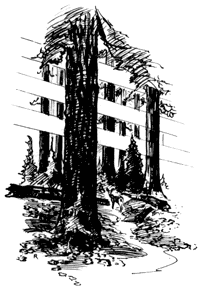The Rim in Miniature
By Gordon Walker, Ranger-Naturalist
The idea of the Wizard Island crater being a crater within a crater has been a point of great interest to many visitors. The cartographer of the U. S. Geographical Survey maps of the region seems to have been so intrigued with the idea that he filled it with water on his map. This, of course, could not happen in view of the extremely porous sides of the cone. It is interesting to note, however, how closely the small crater does resemble the wall of the caldera in other respects.
The complete absence of snow on the northern and eastern face of the rim, while quite large quantities remain on the south and west, has often been noted. The same condition was found in mid-July in the small crater. A deep snow bank lay in a perfect crescent around the south and west bank while none remained in the bottom or on the north and east banks. The snow remained in identical pattern because the same forces were operative as those acting within the rim. Prevailing winds from the southwest blow large quantities of snow into the caldera piling up huge drifts on that side. On the opposite side the tendency is to blow the snow out of the rim wall.
The rate of melting is another factor which determines the position of the remaining snow. This in turn is dependent on the duration and intensity of the sunshine which strikes any area. Since it faces north, the south wall receives no direct sunlight for long portions of the year, and during the longer days when the sun is highest it receives only a few thinly-spread rays. The west wall receives the direct morning sun but is in the shadow during the hot afternoon sun. The east wall, which receives this hot afternoon sun, and the north wall, which is sunny almost all day all year round, have higher temperatures and lose their thinner cover of snow quickly.
On the northeast portion of the wall this quick removal of winter snow, coupled with higher temperature, enables certain plants such as yellow pine and western white pine to grow at elevations far above their normal upper limits. A circle of white barked pines, a high elevation plant which favors exposed positions, crowns the Wizard Island crater. Not too surprisingly, the only break in this circle is on the northeast side. There a single lodge-pole pine has successfully established itself slightly within the crater where it is warmed by the long hours of direct sun.
Towering Majesty
By Edwin Braun, Ranger-Naturalist
Second in grandeur only to the lake itself are Mazama’s deep forests of giant mountain hemlock. This tree is common along the rim, where it descends the basin walls to the water’s edge, and climbs the flanks of the surrounding ridges almost to timberline. It forms the main body of cover of the higher elevations of the park, extending downward into the lodgepole pine belt. It is a common and conspicuous tree, and yet because its finest stands are slightly removed from the main paths of travel, it is seldom seen in its full magnificence.
Over the greater part of its range, the mountain hemlock is a moderate-sized tree, growing to a maximum of 2-1/2 feet in diameter and 90 feet in height. Here, however, it grows to 6 feet and more in diameter and 120 to 130 feet in height in the most favored spots. These giants grown in moist, nearly level areas surrounded by dryer ridges and slopes clothed by smaller hemlock. Here the forest floor is clear of brush and clean of tangles of fallen limbs and trunks. The ground is carpeted by small green herbs and shrubs whose thin leaves glow with life in the shafts of golden sun. Beneath these small plants the deeper layer of duff is soft to walk upon, and silhouetted against them, the massive blue-gray trunks rise straight and tall in great colonnades, holding aloft a canopy of green. Butterflies and other insects flit and buzz among the slanting rays of sunshine. Here the air is still and sounds are faint and muffled. Here there is rest and peace.
Go and see these most graceful of trees at their finest. Seek them where they hide deep in the trackless forest among their lesser fellows, and feel the thrill of discovering for yourself these cathedrals of the forest.


